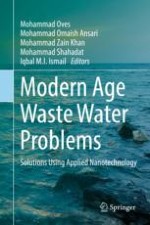2020 | OriginalPaper | Chapter
9. Metal Oxide Nanostructured Materials for Water Treatment: Prospectives and Challenges
Authors : Sayfa Bano, Saima Sultana, Suhail Sabir
Published in: Modern Age Waste Water Problems
Publisher: Springer International Publishing
Activate our intelligent search to find suitable subject content or patents.
Select sections of text to find matching patents with Artificial Intelligence. powered by
Select sections of text to find additional relevant content using AI-assisted search. powered by
